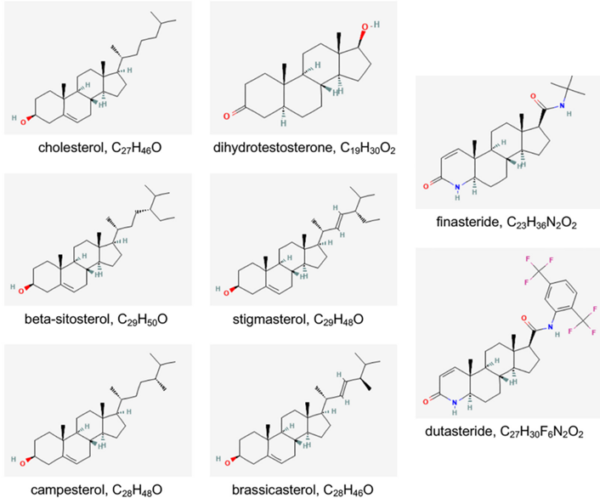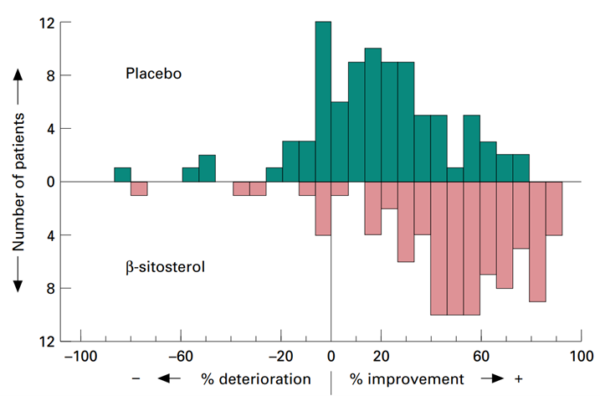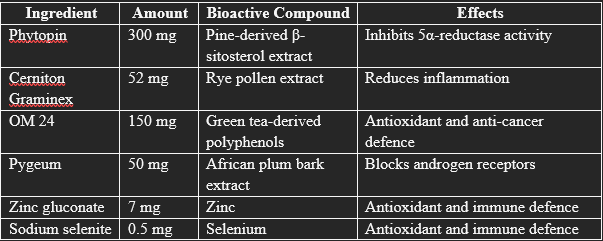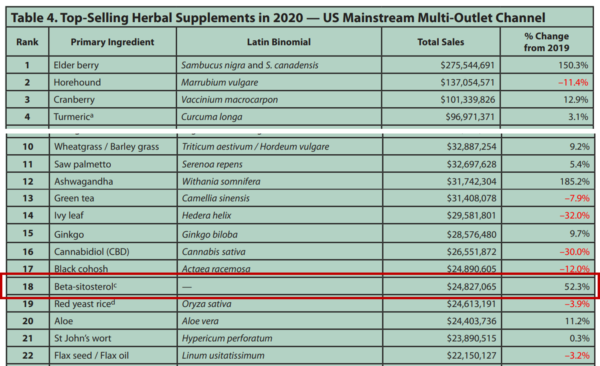With the right approach, managing benign prostatic hyperplasia (BPH) can go beyond simply controlling symptoms – it can enhance your overall health. As modern treatments focus on short-term relief, they often neglect the broader well-being of patients. Our previous newsletter examined how plant extracts like Serenoa repens (saw palmetto) could support prostate health and reduce BPH symptoms. Now, we introduce Prostapinol, a novel formulation that combines pine-derived phytosterols with a selected mix of plant and mineral ingredients. We believe Prostapinol sets a new benchmark for BPH management and men’s health.
First, let us recap that BPH is a non-cancerous enlargement of the prostate gland that obstructs urinary flow, causing symptoms such as nocturia (frequent nighttime urination), incomplete bladder emptying and painful urination. BPH typically affects men over 50, especially those with a family history of BPH, metabolic syndrome or poor lifestyle habits. Treatment options for BPH vary depending on disease severity, which include watchful waiting, lifestyle changes, phytotherapy (phyto- means plant), medications and surgery.
In our prior newsletter, we highlighted that the European Association of Urology released a 2021 clinical guideline recommending hexane-extracted Serenoa repens (HESr) as a treatment option for mild BPH, particularly for men seeking to avoid the potential sexual side effects of standard medications. This recommendation is based on robust evidence from meta-analyses of randomised clinical trials (RCTs) – the gold standard in clinical research – demonstrating the efficacy and safety of HESr in BPH management. In countries like Germany and France, S. repens-based phytotherapy like HESr is an approved medical prescription for BPH.
That said, the precise bioactive compound(s) responsible for the therapeutic effects of HESr remains unclear. Phytochemical profiling reveals that S. repens primarily comprises fatty acids (e.g., lauric and myristic acids) and phytosterols (e.g., β-sitosterol and stigmasterol), which presumably mediate its protective effects against BPH. Indeed, research shows that the fatty acids found in S. repens possess relaxant effects on prostatic smooth muscles. Treatment with lauric and myristic acids has also been shown to prevent BPH in rats. However, the research surrounding the therapeutic efficacy of phytosterols, particularly β-sitosterol, is more compelling, backed by both pre-clinical and clinical evidence.
Figure 1. Molecular structure of cholesterol, dihydrotestosterone (DHT), phytosterols (i.e., β-sitosterol, stigmasterol, campesterol and brassicasterol) and pharmaceutical 5α-reductase inhibitors (i.e., finasteride and dutasteride). Source: Macoska (2023), American Journal of Clinical and Experimental Urology.
A pre-clinical study with a rat model of BPH found that Serenoa repens was more efficacious at suppressing prostate growth and inflammation when it is enriched with β-sitosterol. Further research reveals that β-sitosterol acts as a natural inhibitor of 5α-reductase, the enzyme that converts testosterone to dihydrotestosterone (DHT). As DHT is capable of stimulating prostate cell growth, limiting its synthesis prevents further prostate enlargement.
Standard medications for BPH also include 5α-reductase inhibitors, such as finasteride and dutasteride. Interestingly, these medications are synthetic derivatives of steroids, which share structural similarities with cholesterol and DHT. Similarly, phytosterols like β-sitosterol chemically resemble cholesterol and DHT, as ‘sterol’ means steroid-like plant compounds (Figure 1). This structural resemblance may explain β-sitosterol’s ability to modulate hormonal pathways and mimic the therapeutic actions of pharmaceutical 5α-reductase inhibitors.
Two RCTs conducted in Germany showed that β-sitosterol alone improved urinary symptoms and life quality of BPH patients compared to placebo without causing any significant adverse effects. Most BPH patients treated with β-sitosterol had a 40-90% improvement in symptom scores, compared to only 10-30% in the placebo group (Figure 2). At 18-month follow-up, patients continuing β-sitosterol maintained stable outcomes, while those discontinuing it had slightly worse symptom scores. In the placebo group, patients who started β-sitosterol after the trial also showed similar clinical improvements to the treated group. A more recent RCT from Japan reported that β-sitosterol-enriched S. repens also alleviated urinary symptoms in healthy middle-aged and older men with urinary complaints – suggesting that individuals can benefit from S. repens or β-sitosterol even without a formal diagnosis of BPH.
Figure 2. Changes in the international prostate symptom score among patients with benign prostatic hyperplasia (BPH) in the placebo vs. β-sitosterol group. Source: Klippel et al. (1997), British Journal of Urology.
β-sitosterol is not unique to S. repens. In fact, the RCTs investigating β-sitosterol extracted the compound from other plant species, namely from the Pinus, Picea and Hypoxis genera. Among these, Pinus is the most common commercial source of β-sitosterol due to the abundance, sustainability and climate adaptability of pine trees. One notable example is Phytopin, a highly purified phytosterol extract from pine trees, standardised for β-sitosterol content of at least 70% – much higher than the 3% β-sitosterol content in S. repens.
Importantly, Phytopin is regulated under the European Union’s regulation No. 432/2012, which allows Phytopin to be marketed for its ability to regulate cholesterol levels for cardiovascular health. As phytosterols are structurally similar to cholesterol, they can compete with dietary cholesterol for absorption in the intestines. This competition reduces the levels of low-density lipoprotein (LDL) cholesterol, a known risk factor for cardiovascular diseases. The high β-sitosterol content of Phytopin, however, also makes it valuable for BPH management, thus providing a dual benefit in supporting cardiovascular and prostate health.
To this end, we are excited to introduce Prostapinol, our new product that sets the new standard for managing BPH. This innovative formulation combines the powerful benefits of Phytopin, i.e., pine-derived β-sitosterol, with a selected blend of synergistic plant extracts and minerals, namely Cerniton Graminex, OM 24, Pygeum, zinc and selenium (Table 1). Designed to target multiple pathways involved in BPH progression (e.g., hormonal imbalance, chronic inflammation and oxidative stress) Prostapinol offers a well-rounded solution for improving urinary symptoms while supporting prostate and overall health.
Beyond Phytopin as the primary bioactive component, you may wonder how the other five plant and mineral compounds in Prostapinol contribute to prostate health and beyond. Here is an overview of their roles (Table 1):
- Cerniton Graminex: A proprietary rye pollen extract known for its anti-inflammatory properties, which help reduce prostate swelling and alleviate urinary symptoms. A 2019 RCT demonstrated that rye pollen extract was superior to repens in reducing urinary symptoms and prostatic inflammation scores in patients with prostate- or pelvic-related conditions. Moreover, a 2020 cohort study found that administering rye pollen extract to patients who underwent surgery for BPH led to better clinical outcomes and quality of life compared to the control group without such phytotherapy.
- OM24: A patented green tea extract with potent antioxidant and anti-cancer effects. Although not directly linked to BPH, oxidative stress induces inflammation and DNA damage, which are key drivers of various diseases like cancer. A meta-analysis of three RCTs calculated that green tea extract could reduce the risk of prostate cancer by 62% in high-risk patients, highlighting its broader role in protecting prostate and cellular health.
- Pygeum: A standardised extract from the African plum tree’s bark, known for its ability to modulate hormonal activities. By binding to and occupying androgen receptors, Pygeum helps prevent androgenic hormones like DHT from triggering prostate growth. A meta-analysis of six RCTs found that BPH patients treated with Pygeum had better clinical outcomes compared to placebo, including a 23% increase in peak urine flow and a 24% reduction in residual bladder urine.
- Zinc gluconate: A source of zinc, an essential mineral needed for basic cell functions, including antioxidant and immune defence. Secretory tissues like the prostate have a higher zinc requirement than non-secretory tissues. As follows, low zinc levels in prostatic and seminal fluids are consistently linked to chronic prostate inflammation and prostate cancer. Adequate zinc intake is also known to protect against infections and chronic diseases, such as diabetes, Alzheimer’s disease and cancer.
- Selenium selenite: A source of selenium, an essential trace (required in small amounts) mineral with antioxidant and immunomodulatory properties. Selenium deficiency has been implicated in numerous diseases, including cardiovascular diseases, cancer and male infertility. Selenium may also enhance the therapeutic effects of phytosterols, as evident by clinical studies showing the superior efficacy of selenium-enriched repens in curbing prostate inflammation in BPH patients compared to S. repens alone.
Overall, Prostapinol brings together the latest advancements in phytotherapy to redefine how BPH is managed. By combining six clinically validated ingredients (Table 1), Prostapinol offers a multi-targeted approach that not only alleviates urinary symptoms but also addresses underlying factors like hormonal imbalances, chronic inflammation and oxidative stress to improve prostate health and overall vitality of men.
Table 1. Description of the ingredients of Prostapinol.
Conclusion
Benign prostatic hyperplasia (BPH) is more than a clinical diagnosis; it affects the daily lives and long-term health of millions of men worldwide. With traditional treatments often focused on symptom relief, there is a growing demand for solutions that address the broader picture of health. The numbers tell the story: in 2020, U.S. consumers spent nearly $25 million on β-sitosterol supplements, a 52% increase from the previous year (Figure 3). Products featuring β-sitosterol or Serenoa repens (saw palmetto) now rank among the top-selling supplements in the U.S., as well as many European and Asia-Pacific countries. This trend indicates that men are turning to nature-inspired solutions for prostate and other aspects of health.
Our Prostapinol answers this call with a modern, science-backed approach to prostate health. By leveraging the synergistic power of Phytopin, Cerniton Graminex, OM24, Pygeum, zinc and selenium, it offers more than just symptom relief – it provides a pathway to take control of long-term health. Prostapinol is not just part of a product line; it is part of a larger cultural shift toward informed, proactive and sustainable wellness solutions for men.
Figure 3. Top-selling herbal supplements in the U.S. in 2020. β-sitosterol ranks among the top 20 most popular products and experienced a remarkable 52% increase in sales compared to the previous year, making it one of the fastest-growing supplements on the market. Source: Smith et al. (2021), market report.







